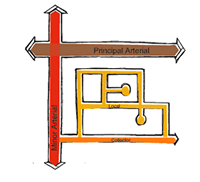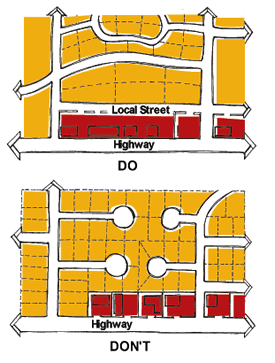10 Ways to Manage Access
Ensure safe and convenient travel in your community by applying these principles when making development decisions.
1. Think land use AND transportation.
Before approving a subdivision or rezoning,consider what road design and improvements will be needed to support the development and link it to the surrounding area.
2. Identify and plan for growth areas.
Incremental and uncoordinated development will not lead to a livable community or a healthy business climate. Support economic growth by planning and investing in a local road network to support development.
3. Develop a complete hierarchy of roads.
A viable community requires a variety of roadways organized as an integrated system. Highways and arterials are needed for longer, higher speed trips. Local streets and collectors provide access to homes and businesses. Recognize that different roads serve different purposes.

4. Link access regulations to roadway function.
Access requirements in your zoning and subdivision regulations should fit each roadway’s functional classification. Recognize that the greatest access control is needed for those roads intended to serve longer, higher speed trips.
5. Avoid strip development. Promote commercial nodes.
Commercial development can be located adjacent to and visible from the highway, but should be accessed via a system of parallel local roads and side streets that complement the state highway system.
6. Connect local streets between subdivisions.
Give your residents convenient options for travel from one neighborhood to another by connecting local streets from one subdivision to the next.

7. Design subdivisions with access onto local streets.
Avoid lot designs with driveways that enter onto major state or county highways. Orient business and residential driveways to local streets that feed onto the highway at a few carefully designed and spaced intersections.
8. Practice good site planning principles.
Locate entrances away from intersection corners and turn lanes. Provide adequate space on the site for trucks to maneuver and for vehicles to queue at drive-through windows without backing or stacking on the roadway. Adjacent businesses should provide shared driveways and cross access so customers can make multiple stops without entering the arterial.
9. Correct existing problems as opportunities arise.
Adopt a long range vision for improving access along older, developed corridors. Correct unsafe accesses as individual parcels expand or redevelop. Work with affected property owners to consolidate driveways and provide internal access between parcels. Fill in the supporting roadway network with local access roads as part of the redevelopment process.
10. Coordinate local development plans with MnDOT and county road agencies.
Share plans for subdivisions, rezonings, and site plans with affected road authorities early in the development process. You don’t even need to wait until development is proposed. Contact MnDOT and your county highway department to talk about your long range plans and development needs.

